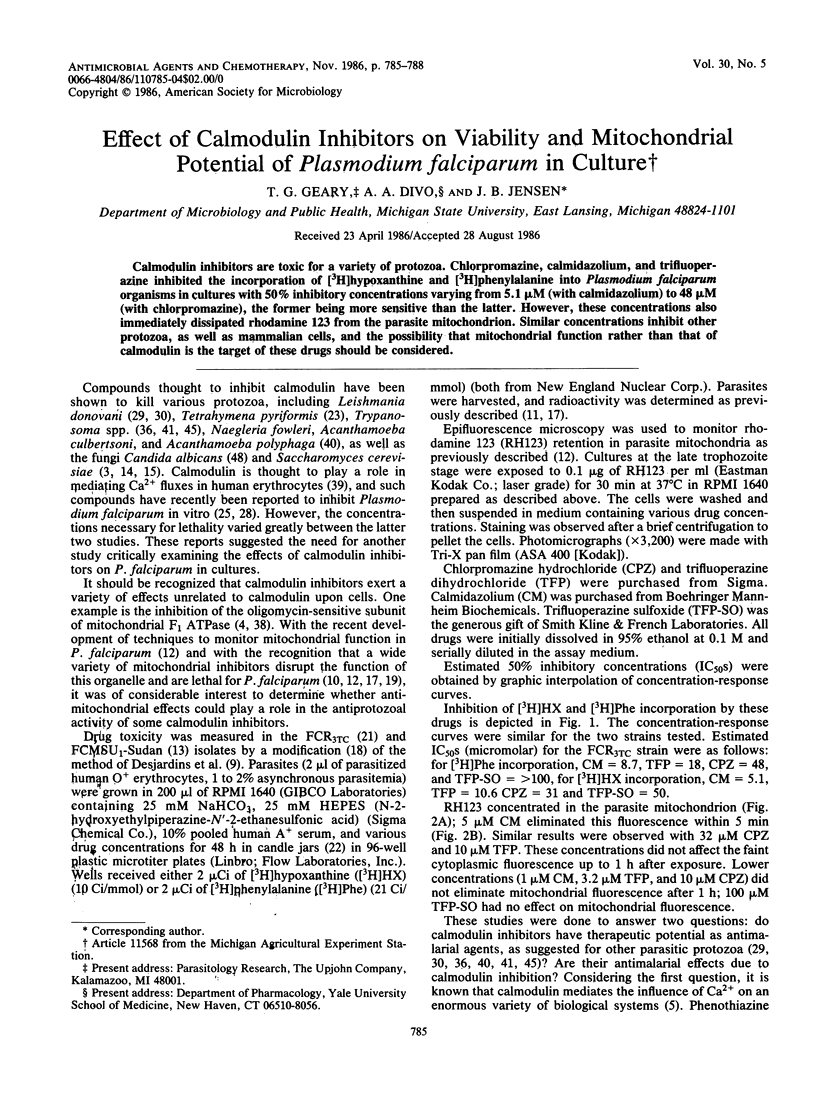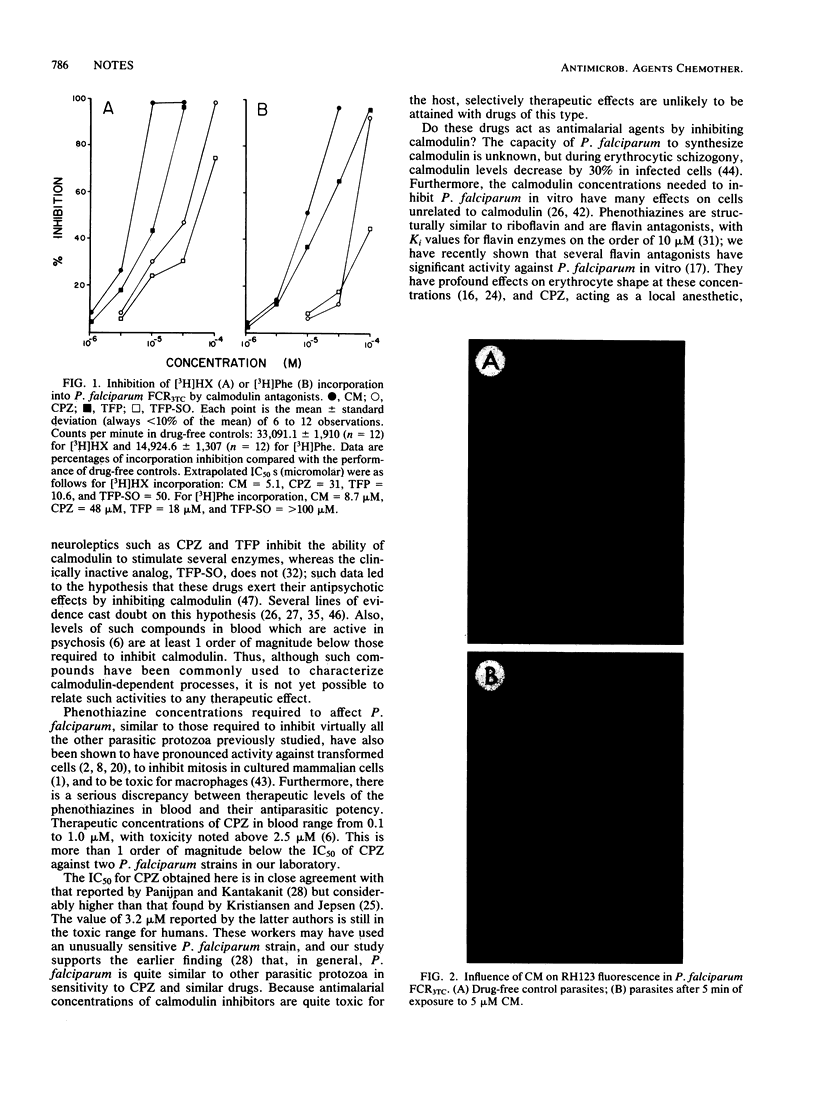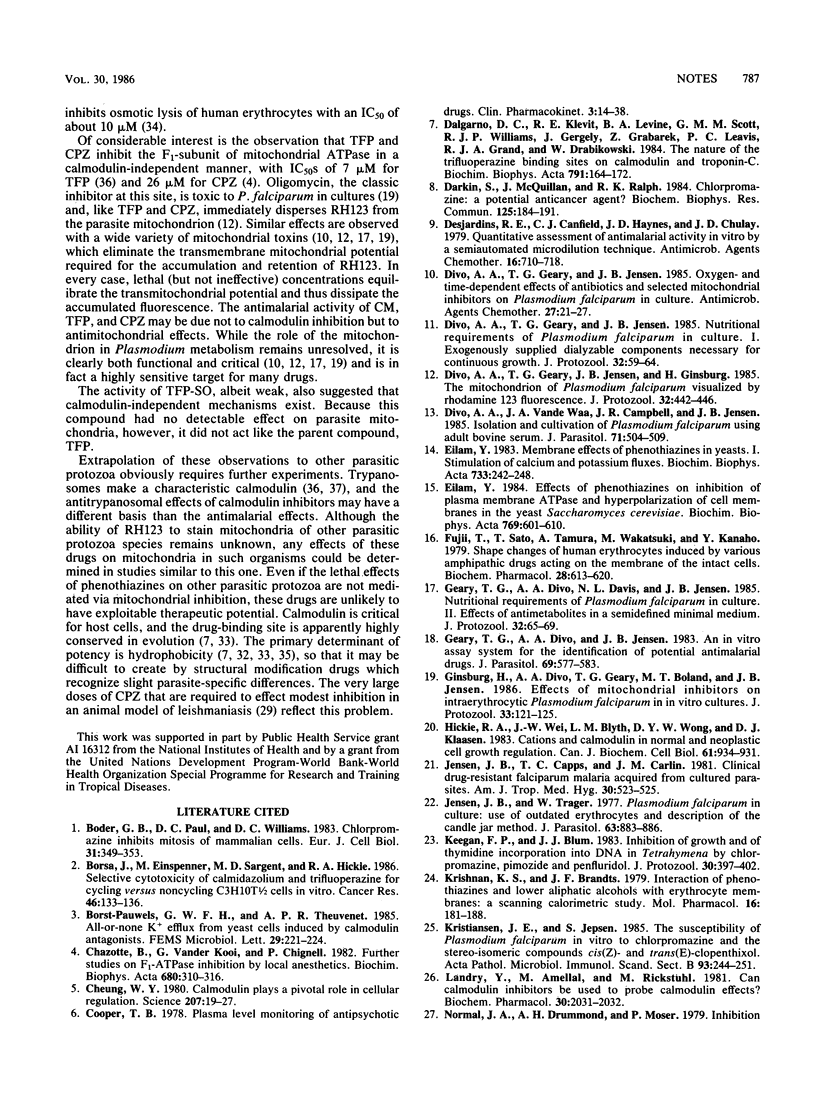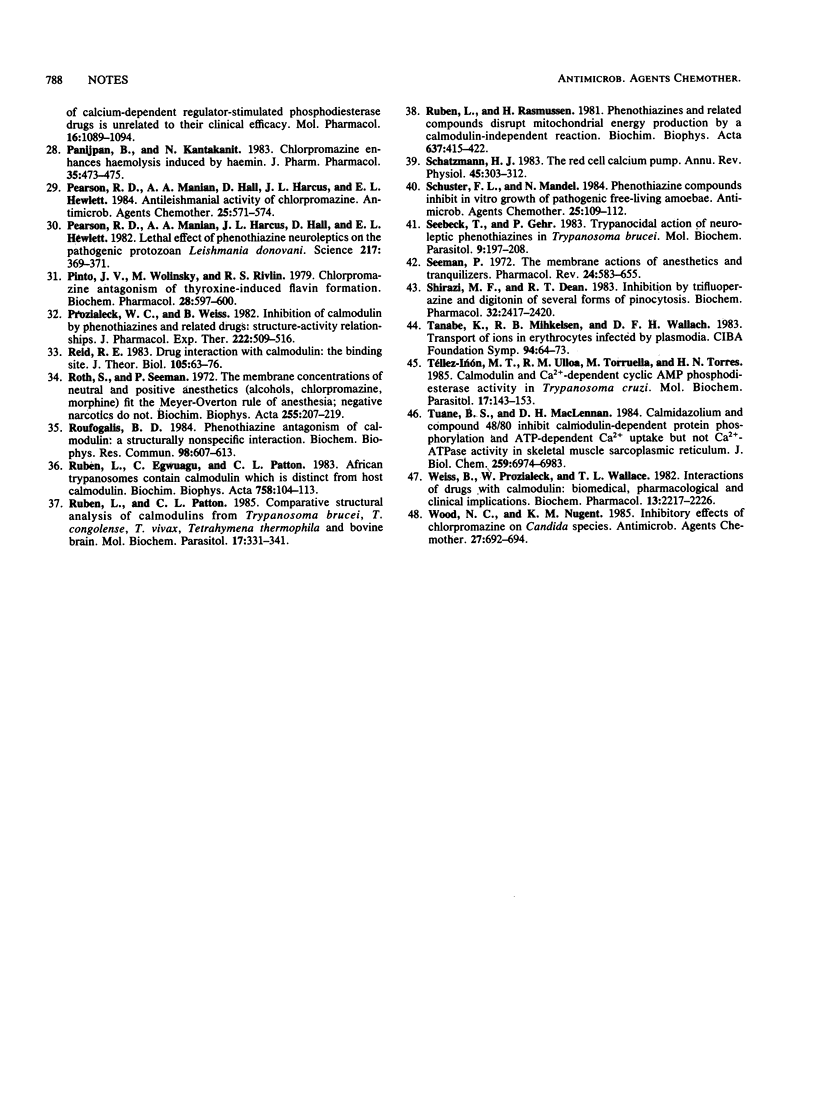Abstract
Calmodulin inhibitors are toxic for a variety of protozoa. Chlorpromazine, calmidazolium, and trifluoperazine inhibited the incorporation of [3H]hypoxanthine and [3H]phenylalanine into Plasmodium falciparum organisms in cultures with 50% inhibitory concentrations varying from 5.1 microM (with calmidazolium) to 48 microM (with chlorpromazine), the former being more sensitive than the latter. However, these concentrations also immediately dissipated rhodamine 123 from the parasite mitochondrion. Similar concentrations inhibit other protozoa, as well as mammalian cells, and the possibility that mitochondrial function rather than that of calmodulin is the target of these drugs should be considered.
Full text
PDF



Images in this article
Selected References
These references are in PubMed. This may not be the complete list of references from this article.
- Boder G. B., Paul D. C., Williams D. C. Chlorpromazine inhibits mitosis of mammalian cells. Eur J Cell Biol. 1983 Sep;31(2):349–353. [PubMed] [Google Scholar]
- Borsa J., Einspenner M., Sargent M. D., Hickie R. A. Selective cytotoxicity of calmidazolium and trifluoperazine for cycling versus noncycling C3H10T1/2 cells in vitro. Cancer Res. 1986 Jan;46(1):133–136. [PubMed] [Google Scholar]
- Chazotte B., Vanderkooi G., Chignell D. Further studies on F1-ATPase inhibition by local anesthetics. Biochim Biophys Acta. 1982 Jun 18;680(3):310–316. doi: 10.1016/0005-2728(82)90144-x. [DOI] [PubMed] [Google Scholar]
- Cheung W. Y. Calmodulin plays a pivotal role in cellular regulation. Science. 1980 Jan 4;207(4426):19–27. doi: 10.1126/science.6243188. [DOI] [PubMed] [Google Scholar]
- Cooper T. B. Plasma level monitoring of antipsychotic drugs. Clin Pharmacokinet. 1978 Jan-Feb;3(1):14–38. doi: 10.2165/00003088-197803010-00002. [DOI] [PubMed] [Google Scholar]
- Dalgarno D. C., Klevit R. E., Levine B. A., Scott G. M., Williams R. J., Gergely J., Grabarek Z., Leavis P. C., Grand R. J., Drabikowski W. The nature of the trifluoperazine binding sites on calmodulin and troponin-C. Biochim Biophys Acta. 1984 Dec 7;791(2):164–172. doi: 10.1016/0167-4838(84)90006-2. [DOI] [PubMed] [Google Scholar]
- Darkin S., McQuillan J., Ralph R. K. Chlorpromazine: a potential anticancer agent? Biochem Biophys Res Commun. 1984 Nov 30;125(1):184–191. doi: 10.1016/s0006-291x(84)80352-6. [DOI] [PubMed] [Google Scholar]
- Desjardins R. E., Canfield C. J., Haynes J. D., Chulay J. D. Quantitative assessment of antimalarial activity in vitro by a semiautomated microdilution technique. Antimicrob Agents Chemother. 1979 Dec;16(6):710–718. doi: 10.1128/aac.16.6.710. [DOI] [PMC free article] [PubMed] [Google Scholar]
- Divo A. A., Geary T. G., Davis N. L., Jensen J. B. Nutritional requirements of Plasmodium falciparum in culture. I. Exogenously supplied dialyzable components necessary for continuous growth. J Protozool. 1985 Feb;32(1):59–64. doi: 10.1111/j.1550-7408.1985.tb03013.x. [DOI] [PubMed] [Google Scholar]
- Divo A. A., Geary T. G., Jensen J. B., Ginsburg H. The mitochondrion of Plasmodium falciparum visualized by rhodamine 123 fluorescence. J Protozool. 1985 Aug;32(3):442–446. doi: 10.1111/j.1550-7408.1985.tb04041.x. [DOI] [PubMed] [Google Scholar]
- Divo A. A., Geary T. G., Jensen J. B. Oxygen- and time-dependent effects of antibiotics and selected mitochondrial inhibitors on Plasmodium falciparum in culture. Antimicrob Agents Chemother. 1985 Jan;27(1):21–27. doi: 10.1128/aac.27.1.21. [DOI] [PMC free article] [PubMed] [Google Scholar]
- Divo A. A., Vande Waa J. A., Campbell J. R., Jensen J. B. Isolation and cultivation of Plasmodium falciparum using adult bovine serum. J Parasitol. 1985 Aug;71(4):504–509. [PubMed] [Google Scholar]
- Eilam Y. Effects of phenothiazines on inhibition of plasma membrane ATPase and hyperpolarization of cell membranes in the yeast Saccharomyces cerevisiae. Biochim Biophys Acta. 1984 Feb 15;769(3):601–610. doi: 10.1016/0005-2736(84)90059-2. [DOI] [PubMed] [Google Scholar]
- Eilam Y. Membrane effects of phenothiazines in yeasts. I. Stimulation of calcium and potassium fluxes. Biochim Biophys Acta. 1983 Sep 7;733(2):242–248. doi: 10.1016/0005-2736(83)90528-x. [DOI] [PubMed] [Google Scholar]
- Fujii T., Sato T., Tamura A., Wakatsuki M., Kanaho Y. Shape changes of human erythrocytes induced by various amphipathic drugs acting on the membrane of the intact cells. Biochem Pharmacol. 1979 Mar 1;28(5):613–620. doi: 10.1016/0006-2952(79)90144-8. [DOI] [PubMed] [Google Scholar]
- Geary T. G., Divo A. A., Jensen J. B. An in vitro assay system for the identification of potential antimalarial drugs. J Parasitol. 1983 Jun;69(3):577–583. [PubMed] [Google Scholar]
- Geary T. G., Divo A. A., Jensen J. B. Nutritional requirements of Plasmodium falciparum in culture. II. Effects of antimetabolites in a semi-defined medium. J Protozool. 1985 Feb;32(1):65–69. doi: 10.1111/j.1550-7408.1985.tb03014.x. [DOI] [PubMed] [Google Scholar]
- Ginsburg H., Divo A. A., Geary T. G., Boland M. T., Jensen J. B. Effects of mitochondrial inhibitors on intraerythrocytic Plasmodium falciparum in in vitro cultures. J Protozool. 1986 Feb;33(1):121–125. doi: 10.1111/j.1550-7408.1986.tb05570.x. [DOI] [PubMed] [Google Scholar]
- Hickie R. A., Wei J. W., Blyth L. M., Wong D. Y., Klaassen D. J. Cations and calmodulin in normal and neoplastic cell growth regulation. Can J Biochem Cell Biol. 1983 Aug;61(8):934–941. doi: 10.1139/o83-119. [DOI] [PubMed] [Google Scholar]
- Jensen J. B., Capps T. C., Carlin J. M. Clinical drug-resistant falciparum malaria acquired from cultured parasites. Am J Trop Med Hyg. 1981 May;30(3):523–525. doi: 10.4269/ajtmh.1981.30.523. [DOI] [PubMed] [Google Scholar]
- Jensen J. B., Trager W. Plasmodium falciparum in culture: use of outdated erthrocytes and description of the candle jar method. J Parasitol. 1977 Oct;63(5):883–886. [PubMed] [Google Scholar]
- Keegan F. P., Blum J. J. Inhibition of growth and of thymidine incorporation into DNA in Tetrahymena by chlorpromazine, pimozide and penfluridol. J Protozool. 1983 May;30(2):397–402. doi: 10.1111/j.1550-7408.1983.tb02938.x. [DOI] [PubMed] [Google Scholar]
- Krishnan K. S., Brandts J. F. Interaction of phenothiazines and lower aliphatic alcohols with erythrocyte membranes: a scanning calorimetric study. Mol Pharmacol. 1979 Jul;16(1):181–188. [PubMed] [Google Scholar]
- Kristiansen J. E., Jepsen S. The susceptibility of Plasmodium falciparum in vitro to chlorpromazine and the stereo-isomeric compounds cis(Z)- and trans(E)-clopenthixol. Acta Pathol Microbiol Immunol Scand B. 1985 Jun;93(3):249–251. doi: 10.1111/j.1699-0463.1985.tb02884.x. [DOI] [PubMed] [Google Scholar]
- Landry Y., Amellal M., Ruckstuhl M. Can calmodulin inhibitors be used to probe calmodulin effects? Biochem Pharmacol. 1981 Jul 15;30(14):2031–2032. doi: 10.1016/0006-2952(81)90217-3. [DOI] [PubMed] [Google Scholar]
- Norman J. A., Drummond A. H., Moser P. Inhibition of calcium-dependent regulator-stimulated phosphodiesterase activity by neuroleptic drugs is unrelated to their clinical efficacy. Mol Pharmacol. 1979 Nov;16(3):1089–1094. [PubMed] [Google Scholar]
- Pearson R. D., Manian A. A., Hall D., Harcus J. L., Hewlett E. L. Antileishmanial activity of chlorpromazine. Antimicrob Agents Chemother. 1984 May;25(5):571–574. doi: 10.1128/aac.25.5.571. [DOI] [PMC free article] [PubMed] [Google Scholar]
- Pearson R. D., Manian A. A., Harcus J. L., Hall D., Hewlett E. L. Lethal effect of phenothiazine neuroleptics on the pathogenic protozoan Leishmania donovani. Science. 1982 Jul 23;217(4557):369–371. doi: 10.1126/science.6124040. [DOI] [PubMed] [Google Scholar]
- Pinto J., Wolinsky M., Rivlin R. S. Chlorpromazine antagonism of thyroxine-induced flavin formation. Biochem Pharmacol. 1979 Mar 1;28(5):597–600. doi: 10.1016/0006-2952(79)90141-2. [DOI] [PubMed] [Google Scholar]
- Prozialeck W. C., Weiss B. Inhibition of calmodulin by phenothiazines and related drugs: structure-activity relationships. J Pharmacol Exp Ther. 1982 Sep;222(3):509–516. [PubMed] [Google Scholar]
- Reid R. E. Drug interaction with calmodulin: the binding site. J Theor Biol. 1983 Nov 7;105(1):63–76. doi: 10.1016/0022-5193(83)90424-1. [DOI] [PubMed] [Google Scholar]
- Roth S., Seeman P. The membrane concentrations of neutral and positive anesthetics (alcohols, chlorpromazine, morphine) fit the Meyer-Overton rule of anesthesia; negative narcotics do not. Biochim Biophys Acta. 1972 Jan 17;255(1):207–219. doi: 10.1016/0005-2736(72)90023-5. [DOI] [PubMed] [Google Scholar]
- Roufogalis B. D. Phenothiazine antagonism of calmodulin: a structurally-nonspecific interaction. Biochem Biophys Res Commun. 1981 Feb 12;98(3):607–613. doi: 10.1016/0006-291x(81)91157-8. [DOI] [PubMed] [Google Scholar]
- Ruben L., Egwuagu C., Patton C. L. African trypanosomes contain calmodulin which is distinct from host calmodulin. Biochim Biophys Acta. 1983 Jul 29;758(2):104–113. doi: 10.1016/0304-4165(83)90290-8. [DOI] [PubMed] [Google Scholar]
- Ruben L., Patton C. L. Comparative structural analysis of calmodulins from Trypanosoma brucei, T. congolense, T. vivax, Tetrahymena thermophila and bovine brain. Mol Biochem Parasitol. 1985 Dec;17(3):331–341. doi: 10.1016/0166-6851(85)90007-6. [DOI] [PubMed] [Google Scholar]
- Ruben L., Rasmussen H. Phenothiazines and related compounds disrupt mitochondrial energy production by a calmodulin-independent reaction. Biochim Biophys Acta. 1981 Oct 12;637(3):415–422. doi: 10.1016/0005-2728(81)90046-3. [DOI] [PubMed] [Google Scholar]
- Schatzmann H. J. The red cell calcium pump. Annu Rev Physiol. 1983;45:303–312. doi: 10.1146/annurev.ph.45.030183.001511. [DOI] [PubMed] [Google Scholar]
- Schuster F. L., Mandel N. Phenothiazine compounds inhibit in vitro growth of pathogenic free-living amoebae. Antimicrob Agents Chemother. 1984 Jan;25(1):109–112. doi: 10.1128/aac.25.1.109. [DOI] [PMC free article] [PubMed] [Google Scholar]
- Seebeck T., Gehr P. Trypanocidal action of neuroleptic phenothiazines in Trypanosoma brucei. Mol Biochem Parasitol. 1983 Nov;9(3):197–208. doi: 10.1016/0166-6851(83)90097-x. [DOI] [PubMed] [Google Scholar]
- Seeman P. The membrane actions of anesthetics and tranquilizers. Pharmacol Rev. 1972 Dec;24(4):583–655. [PubMed] [Google Scholar]
- Shirazi M. F., Dean R. T. Inhibition by trifluoperazine and digitonin of several forms of pinocytosis. Biochem Pharmacol. 1983 Aug 15;32(16):2417–2420. doi: 10.1016/0006-2952(83)90685-8. [DOI] [PubMed] [Google Scholar]
- Tanabe K., Mikkelsen R. B., Wallach D. F. Transport of ions in erythrocytes infected by plasmodia. Ciba Found Symp. 1983;94:64–73. doi: 10.1002/9780470715444.ch5. [DOI] [PubMed] [Google Scholar]
- Tuana B. S., MacLennan D. H. Calmidazolium and compound 48/80 inhibit calmodulin-dependent protein phosphorylation and ATP-dependent Ca2+ uptake but not Ca2+-ATPase activity in skeletal muscle sarcoplasmic reticulum. J Biol Chem. 1984 Jun 10;259(11):6979–6983. [PubMed] [Google Scholar]
- Téllez-Iñn M. T., Ulloa R. M., Torruella M., Torres H. N. Calmodulin and Ca2+-dependent cyclic AMP phosphodiesterase activity in Trypanosoma cruzi. Mol Biochem Parasitol. 1985 Nov;17(2):143–153. doi: 10.1016/0166-6851(85)90013-1. [DOI] [PubMed] [Google Scholar]
- Weiss B., Prozialeck W. C., Wallace T. L. Interaction of drugs with calmodulin. Biochemical, pharmacological and clinical implications. Biochem Pharmacol. 1982 Jul 1;31(13):2217–2226. doi: 10.1016/0006-2952(82)90104-6. [DOI] [PubMed] [Google Scholar]
- Wood N. C., Nugent K. M. Inhibitory effects of chlorpromazine on Candida species. Antimicrob Agents Chemother. 1985 May;27(5):692–694. doi: 10.1128/aac.27.5.692. [DOI] [PMC free article] [PubMed] [Google Scholar]



